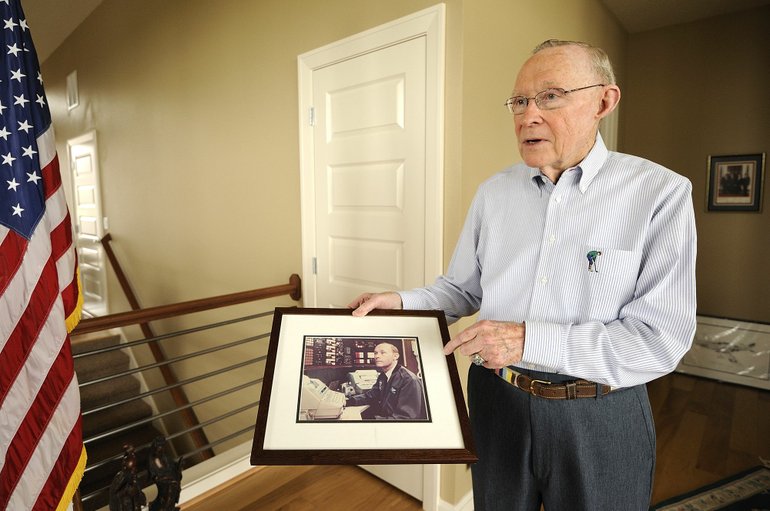Air Force One is the designation for any Air Force plane carrying the president. Two highly customized Boeing 747 aircraft serve in that role, with tail numbers 28000 and 29000.
SOURCE: http://www.whitehouse.gov.
The world just got another lesson in how much of the president’s job happens behind the scenes. People often don’t know what’s been going on until a news alert flashes across the TV screen and their jaws drop.
For about 15 years, Vancouver’s Earl Van Valkenberg was behind the scenes. He served five presidents as chief communicator on Air Force One.
As chief of the communications center on the presidential jet, Van Valkenberg made sure Lyndon Johnson, Richard Nixon, Gerald Ford, Jimmy Carter and Ronald Reagan were always in contact with the White House.
“I could be anywhere in the world and call any number in the world,” he said.
Van Valkenberg didn’t always know what the messages were. But his communications center, and the radio operators he supervised, transmitted some dispatches that helped shape history.
The Nixon administration provided a few of those moments, including a ground-breaking flight to China with Henry Kissinger. Over the course of several visits, they flew Defense Department officials to China, then White House communications people.
“Nixon’s first trip was my fourth trip” to China, the retired Air Force chief master sergeant said.
Another memorable trip didn’t figure into world events, but it offered an example of the pace of the job. Van, as he prefers to be called, wasn’t scheduled to work, and he wasn’t dressed for Air Force One duty; he went aboard to man the console when the on-duty communications officer took a break.
Then a car with flashing lights pulled up, a VIP rushed on board and the pilot ordered, “Let’s go!”
Van spent the next 47 hours flying to India and London and back. All he had was the clothes he’d been wearing — no tie — and a shaving kit provided by a flight attendant.
Van also played a role in designing different versions of the flying communications center. At one point, he said, the communications system featured 85 phones and three fax machines. There have been upgrades since then, including new aircraft.
Van said he worked 12 hours a day for three months to help set up the system when Boeing was preparing a new jetliner to become Air Force One.
Before Van retired, he was called to the Boeing plant in Wichita, Kan., to look at some of the plans for the new 747 aircraft. Van said he pointed out 789 things to correct.
Not everything got corrected. Van was home in Vancouver, enjoying his retirement, when a Boeing official called to say that things didn’t seem to be working so well.
Van told them where they went wrong, and, “They pulled 20 miles of wiring.”
Not all of the redesigns on Air Force One involved the communications system.
At one point, Nixon told the pilot that he wanted more room. It came at the expense of a couple of presidential staff members.
Bob Haldeman and John Ehrlichman, who went on to become prominent names in the Watergate story, lost a desk and eight chairs in the makeover.
“Nixon got nine extra feet for his stateroom,” Van said. “It cost $1 million.”
The graduate of what was then Vancouver High School spent more than 37 years in the service, including a U.S. Navy hitch at the end of World War II.
He joined the Air Force Reserve in Portland, then went into the regular Air Force. He was assigned to the Special Air Missions Wing, flying VIPs and dignitaries, before he was tabbed for Air Force One near the end of Johnson’s term.
Van’s home — which appropriately features a nice view of Portland International Airport — includes mementoes from his days aboard the flying White House. There’s a NASA jacket on a coat hook, recalling several flights transporting astronauts.
“We’d pick them up in Hawaii and fly them to Houston,” the 83-year-old veteran said.
A bowl holds matchbooks and a pack of cigarettes with the presidential seal, popular giveaways to passengers and guests — until Carter called a halt.
“Carter said we were giving thousands of dollars a month away off that airplane,” Van said.
The White House sent four trucks to the hangar to haul away all the freebies. “Not before I got an item or two,” Van said.
Actually, it had all been donated.
“It didn’t cost us a penny. Carter didn’t ask,” he said.
Van was there for a presidential moment that became a punch line, after Air Force One landed in Austria in 1975. President Ford and first lady Betty Ford were walking down the metal steps in the rain.
“On the second step from the bottom, he slipped and fell. The Secret Service thought the president had been shot,” he said.
Comedians turned the misstep into a long-running joke.
Ford had a punch line of his own, however, after the following day’s flight. As Ford headed down the ramp, “He took two steps and froze. The Secret Service was bumping into his back. They were starting to reach under their jackets,” Van said, pretending to draw a gun.
Ford told everyone to calm down, and then Van heard the president ask his security detail: “Where’s Betty?”
“Sir, she’s still back in the stateroom,” Van heard someone say.
“Good,” replied the president. “Let’s go. She’s not going to trip me again.”




